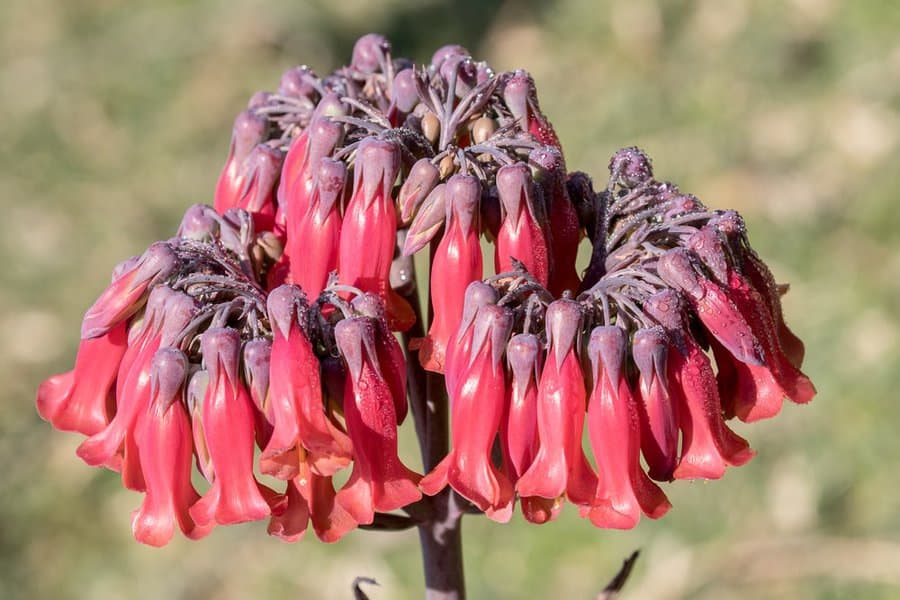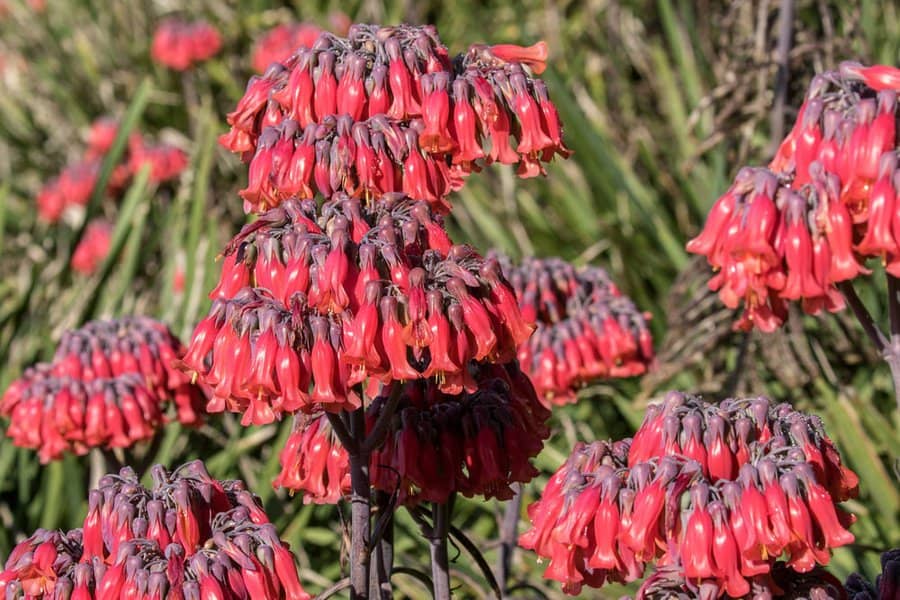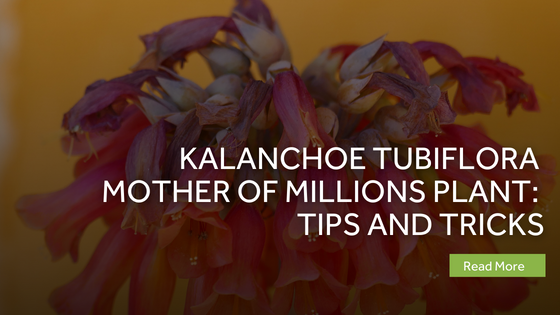Are you looking for a beautiful Kalanchoe succulent plant with many flowers lasting for months? The Kalanchoe tubiflora, or chandelier plant, is a lovely addition to any space. With vibrant orange and coral blooms, this species is sure to impress.
Table of Contents
Kalanchoe Tubiflora Mother of Millions Plant Overview
The Kalanchoe tubiflora Mother of Millions plant is a very popular choice amongst plant lovers everywhere. Native to Madagascar, this species is known for producing many tiny plantlets in its lifetime and gorgeous blooms that can last up to six months with the proper Kalanchoe care.
The Kalanchoe tubiflora has many common names, such as the mother of millions, chandelier plant, Kalanchoe delagoensis, and the Kalanchoe Maternity Plant. The Kalanchoe tubiflora is a member of the Crassulaceae family and part of the Kalanchoe genus. This large and diverse genus contains many succulents with gorgeous flowers and foliage.
Other notable members of the Kalanchoe genus include the Kalanchoe blossfeldiana, Kalanchoe pinnata, and the Kalanchoe longiflora. Kalanchoe Types:
Kalanchoe blossfeldiana: This succulent is called the “Flaming Katy” for its stunning pink, orange, or purple blooms.
Kalanchoe pinnata: The “Cathedral Bells” succulent plant is light green, and the leaves produce small bullet-like structures on the edges of their leaves.
Kalanchoe longiflora: This species is rare in the wild and produces sunny yellow flowers.
| Botanical Name | Kalanchoe tubiflora |
| Family | Crassulaceae |
| Genus | Kalanchoe |
| Origin | Madagascar |
| Kalanchoe Light Requirements | Bright indirect sunlight |
| Watering | Low |
| Soil | Well draining soil |
| Temperature | 60-85 degrees Fahrenheit |
| Propagation | Buds or stem cuttings |
| Re-Potting | Every two years |
| Pests and Diseases | Mealybugs, leaf issues |
| Toxicity | Non-toxic to humans, toxic to animals |

Kalanchoe Tubiflora Mother of Millions Plant Features
The Chandelier plant can grow to a height of 3 feet with tall and fleshy stems that produce tons of beautiful flowers in shades of coral and orange. The leaves of this plant are around five inches wide and are a light green color with purplish accents.
The crowning glory of the Kalanchoe tubiflora is its blooms. The plant is not only beautiful in its coloring but has tubular-shaped flowers that can last up to six months with proper care. The flowers do not produce fruit after their time is up.
While the Kalanchoe tubiflora is generally non-toxic to humans, it is still best practice to keep houseplants out of the reach of children. This plant is toxic to animals, causing harm to many of their body systems.
Kalanchoe Tubiflora Mother of Millions Plant Care Guide
You may be wondering how to care for a Kalanchoe plant. The chandelier plant is a succulent plant whose care is fairly straightforward. This species is a low-maintenance plant with low watering, bright light, warm temperatures, and low humidity preferences.
The Kalanchoe tubiflora Mother of Millions plant does well with fertilizer additions during the growing season but not so much during dormancy. Like many succulent plants we know and love, Kolanchoe plant care is straightforward and easy.
Ideal Growing Place
The Kalanchoe tubiflora species can successfully grow indoors as a houseplant in ceramic potting and outdoors in the right climate. If you choose to grow your plant indoors, enforce the right watering schedule, temperature range, humidity, and lighting.
If you choose to grow your chandelier plant outdoors, check that your climate aligns with the proper Kalanchoe tubiflora care guidelines. Additionally, if your area experiences temperature fluctuations, bring your plant inside when temperatures fall below 50 degrees Fahrenheit.
The growing season for the chandelier plant falls during the warm months of spring and summer. Fall and winter bring dormancy and reduced growth.
Water
The Kalanchoe tubiflora Mother of Millions plant has low watering requirements, and they are drought tolerant. The leaves of succulent plants are great at maintaining water retention, so watering frequency can be lower than other plants. It is best to water your chandelier plant when the soil is completely dry. Soil moisture sensors are available to help with this.
This plant species does not do well with too much water, so be sure to only water when necessary and avoid harmful root rot. Water your plant every one to two weeks during the summer and warmer months, depending on how dry the soil is. In winter, you may be able to water every three weeks or once a month due to slower growth.
Sunlight
Succulents love bright indirect light, and the Kalanchoe tubiflora is no different. However, avoid direct sunlight as this can scorch the beautiful foliage of the plant. If you plan to plant your Kalanchoe species outdoors, avoid areas with intense sun and consider bright shady spaces.
If your chandelier plant is indoors, place your plant near east or west-facing windows but not in direct sun exposure. Your plant should receive around four hours of bright indirect light a day. If your plant does not receive enough light, it can have stunted growth and thinner stems.
Temperature
The Kalanchoe tubiflora Mother of Millions plant prefers warmer temperatures of 60-85 degrees Fahrenheit. However, this plant can tolerate temperatures down to 45 degrees Fahrenheit, which is a plus if this is in your outdoor space. Below that, you will need to bring your plants inside.
The magic temperature to encourage the Kalanchoe tubiflora blooms is 60 degrees Fahrenheit. Monitor outside temperatures if you want to see those flowers last up to six months.
Soil
Kalanchoe tubiflora’s natural habitat is used to dry seasons and heavy rain monsoons, so it grows naturally in well-drained soil. However, since you’re probably not in Madagascar, you must mimic this with a well-draining potting mix.
To create this mixture, use soil additions like perlite, cactus mix, and pumice. These materials help the potting soil reduce extra water retention, reducing the risk of root rot. It is important to follow these soil requirements, but the pot type also affects soil moisture. Ceramic or terracotta pots are best to help airflow and reduce soggy soil.
You May Also Like: pH of The Soil – Why Is It Important
Humidity
The Kalanchoe tubiflora prefers an environment with low humidity of around 40-50%. This is representative of its arid natural conditions. This plant’s foliage can be affected by too much humidity.
Fertilizer
Using a fertilizer on your Kalanchoe tubiflora can be a good idea if it has remained in the same pot for over a year. These extra nutrients can give your plant a needed boost after some time. To do this, give your plant a half-strength liquid fertilizer once a month.
How to Prune Kalanchoe
If your chandelier plant is becoming too large for your preference, use sterilized shears or a blade to trim some height off the top. These leaf cuttings can be used for Kalanchoe tubiflora propagation later. Dead or dying leaves tend to fall off naturally, saving you some time and effort.
Potting and Re-potting
Chandelier plants only need to be repotted about every two years, adding to their low maintenance status. When it is time to repot, find a pot about one to two inches larger than the original, and place the new plant inside with fresh potting soil. Proper draining holes are a must when selecting a new pot.
Growth Zone
The Kalanchoe tubiflora can be successfully grown outdoors if you are in the correct climate. USDA hardiness zones 10a-11b are best suited to grow this species. This region of the hardiness map includes the furthest west coasts of California, Oregon, and Washington and the southernmost borders of Arizona to the east in Florida.
Common Pests, Toxins, Diseases & Other Problems
Common pests that affect many houseplants don’t typically bother the Kalanchoe tubiflora, with the rare exception of Mealy bugs. However, treat your plant with neem oil or insecticidal soap if this pest does stick around.
Other issues you might see with your plant include leggy growth, soft, mushy leaves, and drying leaves. These issues arise when you are over watering, under watering, or providing insufficient lighting.
Propagation
There are a few Kalanchoe propagation methods. To propagate Kalanchoe tubiflora, you can use the stem cuttings method or buds. With stem cutting, locate a stem on the mother plant with one or more nodes and healthy leaves. Then, with sterilized tools, cut the stem section about three to four inches, and set it out to dry and callous for a few days. Once the callous has formed, plant in your soil mixture, water lightly, and wait for new root growth.
Using buds is a simpler method. The Kalanchoe tubiflora will naturally produce what some call “baby plants” or buds off the leaves, each with roots and new leaves. Wait for these to fall off the plant, then place them in the soil mixture, water lightly, and cover with plastic wrap. Place in bright indirect light and wait about a month for growth.
Kalanchoe Tubiflora Mother of Millions Plant Mature Timeline
New root growth will take about four to six weeks if you choose to propagate with stem cuttings. Propagating Kalanchoe with small plantlets or buds requires a month to show new growth.
Once roots have grown to a few inches, plant them in a fresh soil mixture and care for them as you would normally.

Kalanchoe Tubiflora Care FAQ
Are Kalanchoe Tubiflora Annuals or Perennials?
The chandelier plant is a perennial species that will grow for many seasons.
Is Kalanchoe Tubiflora a Fast Grower?
The Kalanchoe tubiflora is a fast-growing succulent species but, unlike other fast growers, only needs to be repotted every two years and doesn’t often require pruning.
How Big and Tall Does Mother of Millions Get?
The Kalanchoe tubiflora can grow about three feet tall, with mature leaves growing about five inches wide.
Is Mother of Millions Invasive?
Kalanchoe tubiflora has the potential to become invasive in warmer climates.
Do Mother of Millions Bloom?
Yes, the chandelier plant is well-known for its plentiful and beautiful blooms that can last up to six months in the right conditions.
How Long Do Kalanchoe Tubiflora Blooms Last?
In the right conditions, especially at 60 degrees Fahrenheit, the blooms on the Kalanchoe tubiflora can last up to six months.
Is Kalanchoe Tubiflora Rare?
The chandelier plant is considered a rare succulent since it is native to one area of the world: Madagascar.
Is Kalanchoe Tubiflora Toxic or Poisonous to Pets and Humans?
The Kalanchoe tubiflora is toxic to animals but not humans. Still, it is a good idea to keep them away from children.
Why Are the Leaves of Kalanchoe Tubiflora Turning Yellow?
Yellowing leaves are a common sign that you are giving your plant too much water.
Why Are New Leaves of Kalanchoe Tubiflora Not Unfurling?
The leaves of your Kalanchoe tubiflora Mother of Millions plant may not be unfurling because they are not receiving enough bright indirect light.
Why Is My Mother of Millions Succulent Drooping?
Drooping is another sign that your plant is receiving too much water. Be sure to only water when the soil is dry.
How Do I Get Rid of Mother of Millions?
If the Kalanchoe tubiflora is invasive in your area, it can be hard to get rid of. Pulling the plants out of the soil and removing all the plantlets in the area is one way to combat this.
What Are the Kalanchoe Tubiflora Mother of Millions Plant Health Benefits?
Traditional medicine and folklore have reported that many Kalanchoe species can be used in medicine to help treat fever, bruising, coughs, and infections.
The Bottom Line
The Kalanchoe tubiflora Mother of Millions plant is a stunning plant, perfect if you are at a novice level or an experienced succulent lover. With proper Mother of Millions care, you will have a thriving plant with gorgeous foliage and vibrant flowers for months!
Last Updated on August 27, 2022 by Gustaf Johansson




